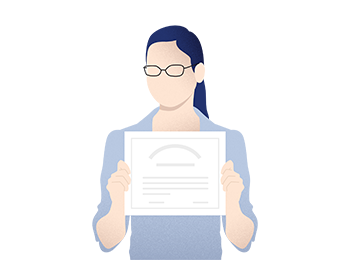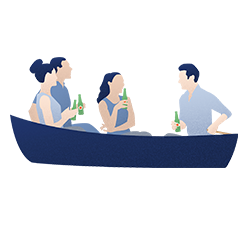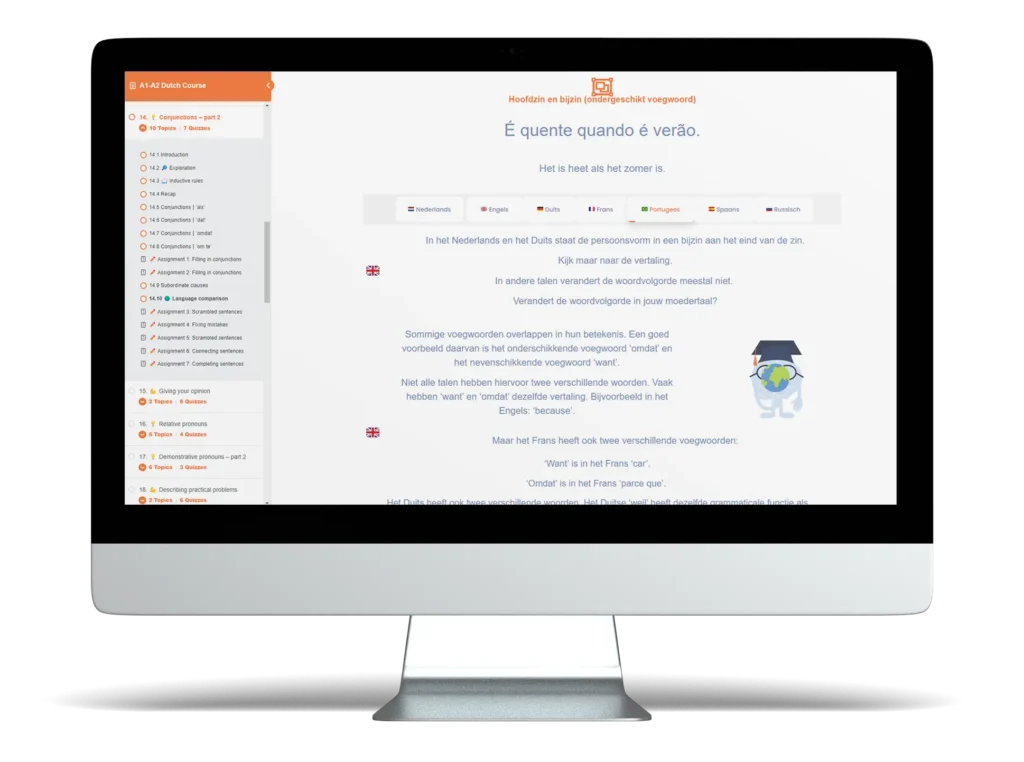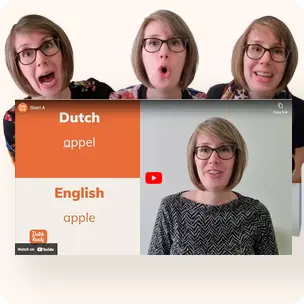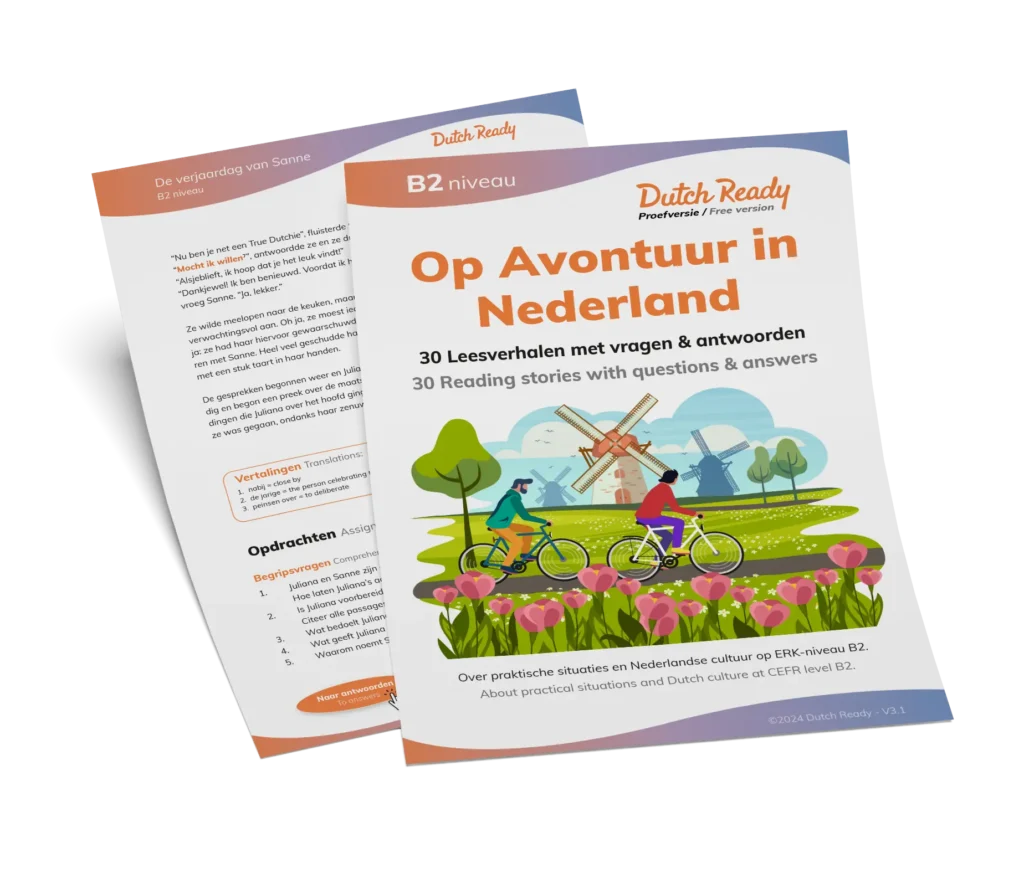

Are you considering learning Dutch, or maybe you’ve already started? The most important basic Dutch grammar rules will get you off to a flying start. And that’s exactly what this blog article is all about! We’ll break down the most essential Dutch grammar concepts and give you useful tips on how to practice.
In this blog article, you’ll read about:
We often get questions like ‘How difficult is Dutch grammar?’ and ‘How easy is it for English speakers to learn Dutch grammar?’ from language learners. Although the opposite is often claimed, Dutch is actually quite an easy language to learn. Practice, exposure and using the right Dutch learning materials are key. Dutch is a member of the Germanic language family, which means you will pick it up even easier if you already speak English and/or another Germanic language like German.
Also, did you know that your native language can help you learn a new language? Understanding the similarities and differences between your native tongue and Dutch speeds up the language learning process. Research demonstrates the importance of insight into the mother language over and over again.
First, let’s start with the articles. Dutch has two definite articles, that you use to identify a specific noun: ‘de’ and ‘het‘. So we started off with some pretty good news, because there are fewer articles in Dutch than in, say, German, French, Spanish, Greek, or Italian. The less good news? Whereas many other languages have clear rules about when to use which article, Dutch is a bit more of a mystery.
The Dutch language has two definite articles, or articles we use for a specific, particular, or known noun. We use the article ‘de’ for masculine and feminine words, and ‘het’ for neuter words. So, how do you know if it’s ‘de’ or ‘het’ in Dutch? Although there are some rules that can help you decide which article to use (for example, words for plants, fruits, and vegetables are de-words), it eventually comes down to learning them by heart, just like the native speakers had to. So whenever you learn a new noun in Dutch, learn its article immediately as well. That means your vocab list should kind of look like this:
de kat (the cat)
het huis (the house)
de tafel (the table)
het boek (the book)
However, the good thing is that there are a few simple rules. The definite noun in plural always has the article ‘de’: de katten, de huizen, de tafels, de ramen. Diminutives always get the article ‘het’, except when you use them in plural, because then, like all other nouns, they also get the article ‘de’. These are actually one of the easiest basic Dutch grammar rules. Take a look:
Noun | Noun in plural | Diminutive | Diminutive in plural |
de kat | de katten | het katje | de katjes |
het huis | de huizen | het huisje | de huisjes |
de tafel | de tafels | het tafeltje | de tafeltjes |
het boek | de boeken | het boekje | de boekjes |
After a while, you will find that you begin to sense which article sounds right with which noun.

Fortunately, the situation is a lot simpler when you need an indefinite article, or an article that you use to introduce a non-specific noun. That is always ‘een’: een kat, een huis, een tafel, een raam. In plural, there’s no indefinite article: katten (cats), huizen (houses), tafels (tables), ramen (windows).
Although nobody gets hurt when you use a wrong article, it’s still important to learn them. After all, you’ll need this knowledge in a host of other grammatical situations. The table below illustrates that.
de kat | Welke kat? (which cat?) | onze kat (our cat) | een grote kat (a big cat) | die grote kat (that big cat) |
het boek | Welk boek? (which book?) | ons boek (our book) | een groot huis (a big house) | dat grote huis (that big house) |
Now that you have read the above information about articles, you know that the article for the plural is always ‘de’. But now let’s have a look at the plural form of the nouns themselves. You can divide the plural forms into three major groups:
In most cases, we form the plural by adding the suffix -en to the singular word.
het boek (the book) – de boeken
de kat (the cat) – de katten
het huis (the house) – de huizen
You can see that there is a spelling change for some plural forms. For example, the plural form of ‘kat’ gets a double ‘t’ and the plural form of ‘huis’ has a ‘z’ instead of an ‘s’. This has to do with the pronunciation of words. We won’t go into more detail about this spelling system in this blog post because it is quite detailed. Would you like to learn more? Our Pronunciation and Spelling Module will teach you all about it.

The second category involves nouns ending in -e, -el, -em, -en, or, -er. These words get the suffix -s. Have a look at these examples:
de lepel – de lepels
het meisje – de meisjes
de jongen – de jongens
Finally, nouns that end in a single a, i, o, u, y get -‘s in their plural form. The apostrophe is there to show that we should keep the pronunciation of that vowel long. For example:
de paraplu – de paraplu’s
de auto – de auto’s
de pyjama – de pyjama’s
Time to move on to the adjectives. If you already learned a little Dutch for beginners, these examples will probably be familiar to you:
groot (big), mooi (beautiful), klein (small), lekker (tasty), interessant (interesting), groen (green), vies (dirty), snel (fast), lief (sweet), goedkoop (cheap)
You may also have noticed that adjectives often end in an -e, so ‘mooie’ instead of ‘mooi’ and ‘kleine’ instead of ‘klein’. Why is that?
When we want to describe a definite (specified) noun, the adjective always gets an -e. For instance: ‘mijn mooie auto’ (my pretty car), ‘deze lekkere taart’ (this tasty pie), ‘het goedkope brood’ (the cheap bread), ‘de kleine kinderen’ (the small children). Hence, the article doesn’t play any role here; the rule applies to both de-words and het-words.
When the article does play a role is when we want to describe an indefinite (unspecified) noun. We then talk about ‘een mooie auto’ (de auto) and ‘een goedkoop brood’ (het brood). The adjectives to indefinite de-words again get an -e, but the adjectives to indefinite het-words do not.
There is one other situation where the adjective does not get an -e, and that is when it’s not in front of the noun, but when it comes later in the sentence. We added examples of this in the overview below.
de-word | het-word | |
definite | de mooie auto | het goedkope brood |
indefinite | een mooie auto | een goedkoop brood |
after the noun | de auto is mooi | het brood is goedkoop |
Let’s move on to the next in line of basic Dutch grammar rules. The difference between stressed and unstressed pronouns tends to stress some Dutch learners. Before we dive into that, let’s have a look at the difference between English and Dutch. After all, language comparisons are always a good way to approach new grammar, and they’ll help you develop your Dutch language skills way faster.
English:
Dutch:
Did you notice that the Dutch counter-question uses a different form of the pronoun than the first question? ‘Je’ is an unstressed pronoun and ‘jou’ is a stressed pronoun. In contrast to the English counter-question, where stress is added by simply pronouncing the pronoun with emphasis, in Dutch, you need a different form of the pronoun to do this.

However, not all pronouns have an emphasized form. Have a look at this overview (the pronouns in bold are emphasized). The pronouns without this stressed form are emphasized by pronouncing the word with extra emphasis, just like in English.
subject | possessive | object |
ik (I) | mijn (mine) | me / mij (me) |
je / jij (you) | je / jouw (your) | je / jou (you) |
u (you, formal) | uw (your) | u (you) |
hij (he) | zijn (his) | hem (him) |
ze / zij (she) | haar (her) | haar (her) |
we / wij (we) | ons, onze (our) | ons (us) |
jullie (you) | jullie (your) | jullie (you) |
ze / zij (they) | hun (their) | ze / hen (them) |
Are you just starting to learn Dutch? The first tense that you come across is the present tense. That is the tense we use to talk about the present, and that can also be used to talk about the future. Let’s see how it is formed. The vast majority of Dutch verbs have an infinitive ending in -en. Think about ‘werken’ (to work), ‘slapen’ (to sleep), ‘fietsen’ (to cycle), ‘eten’ (to eat), and ‘stoppen’ (to stop). Some verbs have a different form, such as ‘gaan’. For convenience, we will use a verb ending in -en in the example below: ‘werken’.
To start, you’ll need the stem of the verb. You’ll find the stem by taking -en from the infinitive. In the case of the verb ‘werken’ that would be: werken – en = werk.
subject | ik | je (jij) | u | hij | ze (zij) | we (wij) | jullie | ze (zij) |
conjugation | stem | stem + t* | stem +t | stem +t | stem +t | infinitive | infinitive | infinitive |
werk | werkt | werkt | werkt | werkt | werken | werken | werken |
Note: whenever the subject and the verb switch places (which we’ll tell more about in the next section), the verb doesn’t get a -t when je or jij comes after it. For example:
Je werkt in Amsterdam.
Werk je in Amsterdam?

Sometimes we have to change the stem of the verb before we can conjugate. It’s one of the basic Dutch grammar rules that have to do with pronunciation again. We change the stem of the verb when it ends in a single vowel that sounds long, and when it ends in a double consonant. Take a look:
slapen (sla-pen) | slaap (instead of slap) | The ‘a’ in ‘slapen’ sounds long, because it’s in an open syllable. The stem of the verb is a closed syllable, ending in a consonant. We have to add a second a to maintain the long sound. |
stoppen (stop-pen) | stop (instead of stopp) | A double consonant at the end of the stem isn’t audible. In other words: we don’t need it. |
As soon as these verbs have more than one syllable, like in the plural form, these changes are undone. Take another look:
subject | ik | je (jij) | u | hij | ze (zij) | we (wij) | jullie | ze (zij) |
slapen | slaap | slaapt | slaapt | slaapt | slaapt | slapen | slapen | slapen |
stoppen | stop | stopt | stopt | stopt | stopt | stoppen | stoppen | stoppen |
Also, when ‘z’ is the last letter of the stem of a verb, we change it into ‘s’. We also change the ‘v’ into ‘z’. That’s how the stem of ‘lezen’, for example, becomes ‘lees’, and the stem of ‘geven’ becomes ‘geef’.
Honesty is the best policy. So, we will admit to you that there are few people who immediately find the Dutch word order logical. But although the syntax is different from that of most other languages, fortunately there are straightforward rules that keep things clear. Dutch is a so-called SVO (subject-verb-object) language. Take a look at the examples below:
Ik kook de pasta (I cook the pasta)
Hij repareert zijn fiets (He repairs his bicycle)
It’s important to know that, unlike some other languages, such as Spanish, Italian, and Greek, a Dutch sentence always needs an explicit subject, otherwise it’s not complete.
And are you adding another verb to the sentence? In that case, the main verb moves to the end of the sentence in its infinitive form. The first verb in the sentence is always conjugated to match the subject. For example:
Ik wil de pasta koken (I want to cook the pasta)
Hij moet zijn fiets repareren (He has to repair his bicycle)
Finally, inversion can also occur, and is one of the basic Dutch grammar rules that you’ll apply pretty quickly. It means that the subject and the finite verb switch places, but they will still always be next to each other. Inversion is needed when you don’t start your main clause with the subject. You can see the difference in the example below:
Ik heb nu tijd. (I have time now)
Nu heb ik tijd. (Now I have time)
Inversion also occurs when we ask a question, regardless of whether we use an interrogative (question word):
Ga je morgen naar Amsterdam? (Are you going to Amsterdam tomorrow?)
Hoe ga je morgen naar Amsterdam? (How are you going to Amsterdam tomorrow?)

By nature, our brains try to make sense of the world around us. This means that consistent immersion in the language will naturally help you absorb grammar without drills. While explanations of basic Dutch grammar rules can get you started, the real work happens when you focus on applying them through activities like conversations and use of media.
If conversations make you nervous, Praatgraag may be of help. This bundle of daily Dutch conversations helps you prepare for common interactions, plus the vocab lists that accompany each chapter will help you boost your fluency and confidence. Praatgraag is available for the levels A1 and A2.
Try to apply Dutch grammar in different situations. That way, you won’t just memorize the rules, but you’ll develop a stronger sense of language and familiarity with Dutch.
Working with a Dutch grammar book may not be your favorite thing to do. Taking out an entire evening to spend hours studying isn’t only a boring prospect, but also something that’s actually not that effective at all. The success of your learning efforts isn’t in how long you study in a row, but in regularity.
Are you afraid to speak Dutch? The only way to overcome this feeling is exposure. Like anything in life, nothing is perfect. And even native speakers make mistakes. Nobody is out to criticize you. Although it can feel like there is never a good time to speak Dutch, every moment is in fact an opportunity. Build it up slowly by starting off with a short conversation with a friend or neighbor. Or speak Dutch with store staff. Have you gotten used to that? Then take the next step, such as a chat with a colleague or speaking some Dutch with your doctor.

Learning Dutch becomes so much more fun and doable when you can apply it immediately and/or connect it to your interests. Are you practicing the conjugation of verbs? Then choose verbs that are important to you, for example, because they have to do with your work or hobbies, or because you want to discuss something with your children’s teacher.
Working with interactive, challenging material can significantly impact your progress. Our e-learning Dutch is anything but rigid textbook language. Instead, we have chosen authentic (spoken and written) material that will best prepare you for the Dutch that natives speak. Moreover, we alternate grammar with practical chapters so you don’t just stick to theoretical knowledge, but you can apply it immediately. And last, but not least: you can practice your Dutch grammar online, as often as you want! We’ve developed a Dutch e-learning A1 level and Dutch e-learning A2 level.
Extra tip: You can also take private Dutch lessons with us using this method. Do you think that a learning path with a tutor is the best fit for you? Buy a test lesson Dutch without any obligation today (a personal intake and level assessment are included in the price), and start working on those basic Dutch grammar rules to kickstart your fluency!
Language lessons & materials designed to help you learn Dutch fast. Use what you know, simplify what you don’t.

Join our newsletter!
Receive free learning tips and stay up to date on deals and courses.
